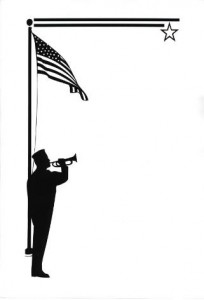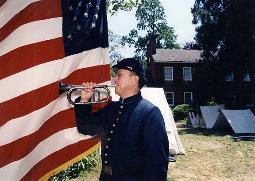A Brief History of the Bugle Call Taps
by Jari Villanueva

24 NOTES THAT TAP DEEP EMOTIONS – A SUMMARY
Of all the military bugle calls, none is more easily recognized or more apt to render emotion than Taps. The melody is both eloquent and haunting. The use and history of Taps is unique to the United States military, as the call is sounded at funerals, wreath-laying and memorial services. There is great interest in the history of Taps.
The Creation of Taps
Taps began as a revision to the signal for Lights Out at the end of the day. Up until the Civil War, the infantry call for Lights Out was the one set down in Silas Casey’s Tactics, which had been borrowed from the French. The music for Taps was adapted by Union General Daniel Butterfield for his brigade (Third Brigade, First Division, Fifth Army Corps, Army of the Potomac) in July, 1862.
General Butterfield was not pleased with the call for Lights Out, feeling that it was too formal to signal the day’s end. With the help of the brigade bugler, Oliver Willcox Norton, Butterfield created Taps to honor his men while in camp at Harrison’s Landing, Virginia following the Seven Days’ battle, which took place during the Peninsular Campaign of 1862. The new call, sounded that night in July, 1862, soon spread to other units of the Union Army and was even used by the Confederates. Taps was made an official bugle call after the war.
Butterfield did not compose Taps but actually revised an earlier bugle call. The 24 note sequence we know today as Taps existed in an early version of the call Tattoo, which had gone out of use by the Civil War. As a signal for the end of the day, armies have used Tattoo to alert troops to prepare for bedtime roll call. General Butterfield knew this call from his days before the war as a colonel for the 12th New York Militia.
The origin of the word Taps is thought by some to have come from the Dutch word for Tattoo, or “Taptoe.”
History of Taps at Funerals
How did Taps become associated with funerals? The earliest official reference to the mandatory use of Taps at military funeral ceremonies is found in the US Army Infantry Drill Regulations for 1891, although it had doubtless been used unofficially long before that time, under its former designation, Extinguish Lights.
Other stories of the origin of Taps exist. A popular myth is that of a Northern boy who was killed fighting for the South. His father, Robert Ellicombe, a captain in the Union Army, came upon his son’s body on the battlefield and found the notes to Taps in a pocket of the dead boy’s Confederate uniform. There is no evidence to back up the story or the existence of a Captain Ellicombe.
“There is something singularly beautiful and appropriate in the music of this wonderful call. Its strains are melancholy, yet full of rest and peace. Its echoes linger in the heart long after its tones have ceased to vibrate in the air.” – Oliver Willcox Norton

Visit www.tapsbugler.com for much more information on:
- The history of Taps
- Information on getting a bugler for a funeral or ceremony
- Ordering a copy of 24 Notes That Tap Deep Emotions
- Music for bugle calls
- Photos of bugles and buglers
- Links to bugle websites
For sheet music of the Civil War era, please visit our store.